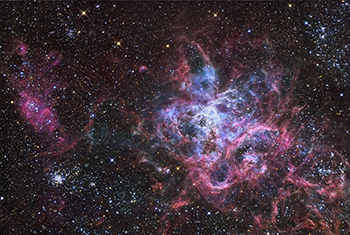
| |
|
|
|
|
|
|
| |
|
|
|
|
|
|
OzSky Star Safari - Southern Skies Showcase:
The Tarantula Nebula
Tarantula Nebula (NGC 2070, Caldwell 30)

Image Credit: R Jay GaBay
| R.A: | 05h 38' 35" |
| Dec: | -69° 05' 36" |
| Mag: | +8.0 |
| Const: | Dorado (Dor) |
| Best at: | OzSky "Southern Spring" Star Safari in October |
The Tarantula Nebula is a spectacular bright emission nebula in the southern constellation of Dorado (Dor).
Shining at an apparent magnitude of +8.0, the Tarantula Nebula is one of the first targets of many observers at The OzSky Star Safaris. Observers at the OzSky Star Safaris in April will typically observe it early in the evening before it gets too low, however the OzSky Star Safari in October is when the Tarantula really showcases itself, rising all night and eventually transiting the October meridian around 5am at an impressive altitude of around 55° above the horizon.
Located at a distance of approximately 160,000 light-years (48 kpc), its apparent magnitude of +8.0 makes it an extremely luminous non-stellar object. Its luminosity is so great that if it were as close to Earth as the Orion Nebula, the Tarantula Nebula would cast visible shadows.
The Tarantula Nebula is the most active starburst region known in the Local Group of galaxies. It is also one of the largest such regions in the Local Group with an estimated diameter of about ~1,000 light years (~300 pc). It is thought to contain more than half a million solar masses in gas and hosts some of the most massive stars known.
The nebula resides on the leading edge of the Large Magellanic Cloud (LMC) where ram pressure stripping, and the compression of the interstellar medium likely resulting from this, is at a maximum.
In it's centre lies a star cluster which includes the compact concentration of stars known as R136 that produces most of the energy that makes the nebula visible. The estimated mass of the cluster is 450,000 solar masses, suggesting it will likely become a globular cluster in the future. In addition to NGC 2070, the Tarantula Nebula contains a number of other star clusters including the much older Hodge 301. The most massive stars of Hodge 301 have already exploded in supernovae.
The closest supernova observed since the invention of the telescope, Supernova 1987A, occurred in the outskirts of the Tarantula Nebula. There is a prominent supernova remnant enclosing the open cluster NGC 2060, but the remnants of many other supernovae are difficult to detect in the complex nebulosity.
References: SkySafari 5 Pro (iPhone app); Wikipedia
Register Now to secure your place at one of these unique OzSky Star Safaris.
OzSky "Alumni" Star Safari (read more...)
Can't make it to the next OzSky "Classic" Star Safari in March? Or perhaps you have already been to several OzSky "Classic" Star Safaris and you are now looking for a different time of year to explore the other half of the Southern night skies?
Why not consider the next OzSky "Alumni" Star Safari instead, for your next Southern Skies observing trip!

